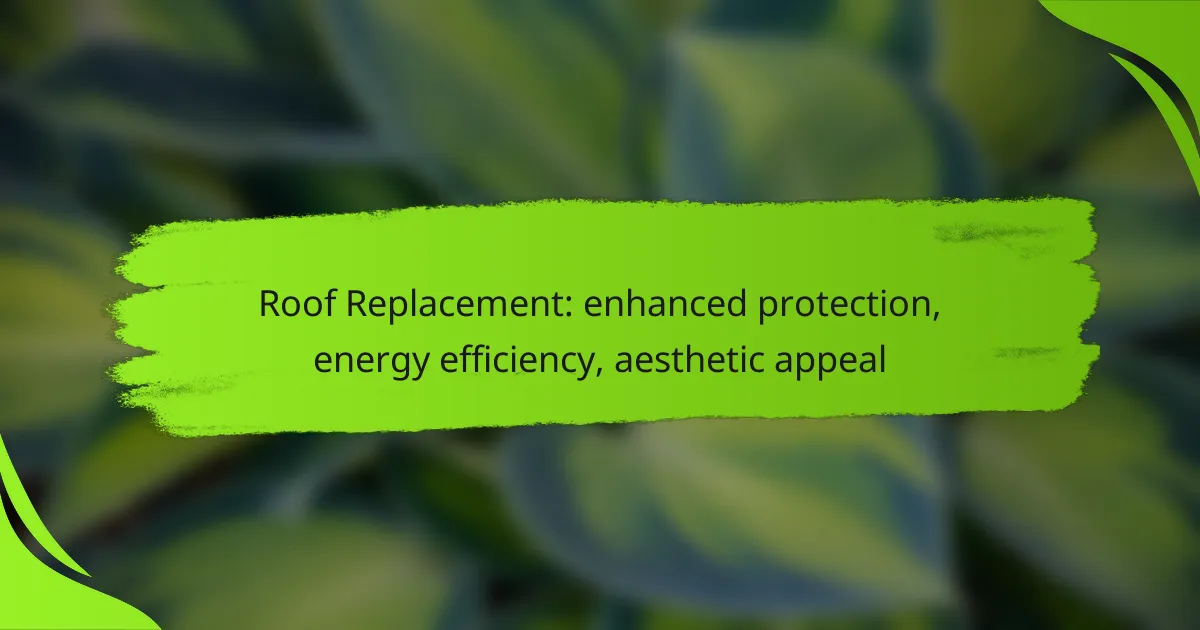Roof replacement is a vital investment for homeowners, particularly in urban areas, as it provides enhanced protection against harsh weather, boosts energy efficiency, and elevates the aesthetic appeal of the property. By utilizing modern materials and techniques, a new roof can significantly lower energy costs while ensuring a comfortable living environment. Additionally, a well-executed roof replacement can increase property value, making it a worthwhile consideration for any homeowner.
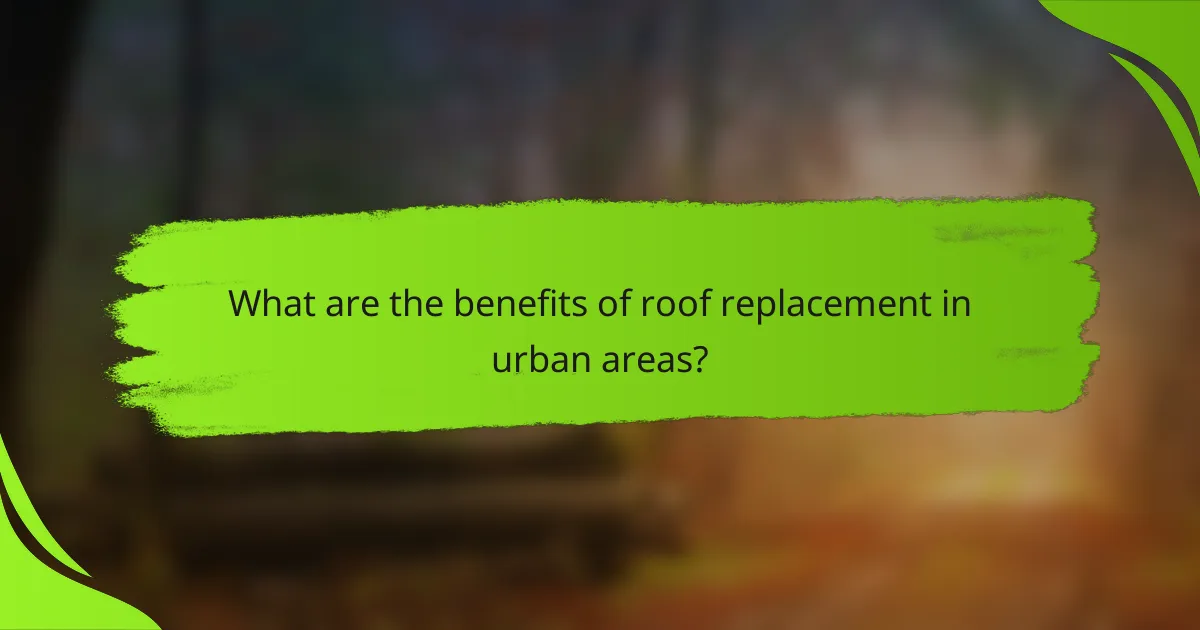
What are the benefits of roof replacement in urban areas?
Roof replacement in urban areas offers several advantages, including enhanced protection against the elements, improved energy efficiency, and increased property value. These benefits are crucial for homeowners looking to maintain their properties in densely populated environments.
Enhanced weather protection
Replacing an old roof significantly boosts its ability to withstand harsh weather conditions, such as heavy rain, snow, and strong winds. Modern roofing materials are designed to be more durable and resistant to leaks, which is essential in urban areas prone to severe weather events.
Consider materials like metal or asphalt shingles, which provide excellent protection and longevity. Regular inspections and maintenance can further enhance the roof’s resilience, ensuring it remains effective against the elements.
Improved energy efficiency
A new roof can dramatically improve a home’s energy efficiency, leading to lower utility bills. Modern roofing systems often include better insulation and reflective materials that help regulate indoor temperatures, reducing the need for heating and cooling.
Homeowners can expect energy savings of around 20-30% with the right roofing materials. Look for options with high energy efficiency ratings, such as cool roofs or those with Energy Star certification, to maximize savings.
Increased property value
Investing in a roof replacement can significantly increase a property’s market value. A new roof not only enhances curb appeal but also assures potential buyers of the home’s structural integrity and reduced maintenance costs.
In urban markets, where competition is high, a well-maintained roof can set a property apart. It’s advisable to keep records of the replacement process and materials used, as these can be persuasive selling points during a property sale.
Modern aesthetic appeal
A roof replacement allows homeowners to choose from a variety of styles and colors that can enhance the overall look of their property. Modern roofing options come in various designs that can complement the architectural style of urban homes.
Consider selecting materials that not only match your home’s aesthetic but also meet local building codes and regulations. A visually appealing roof can significantly contribute to the neighborhood’s charm and desirability, making it a worthwhile investment.
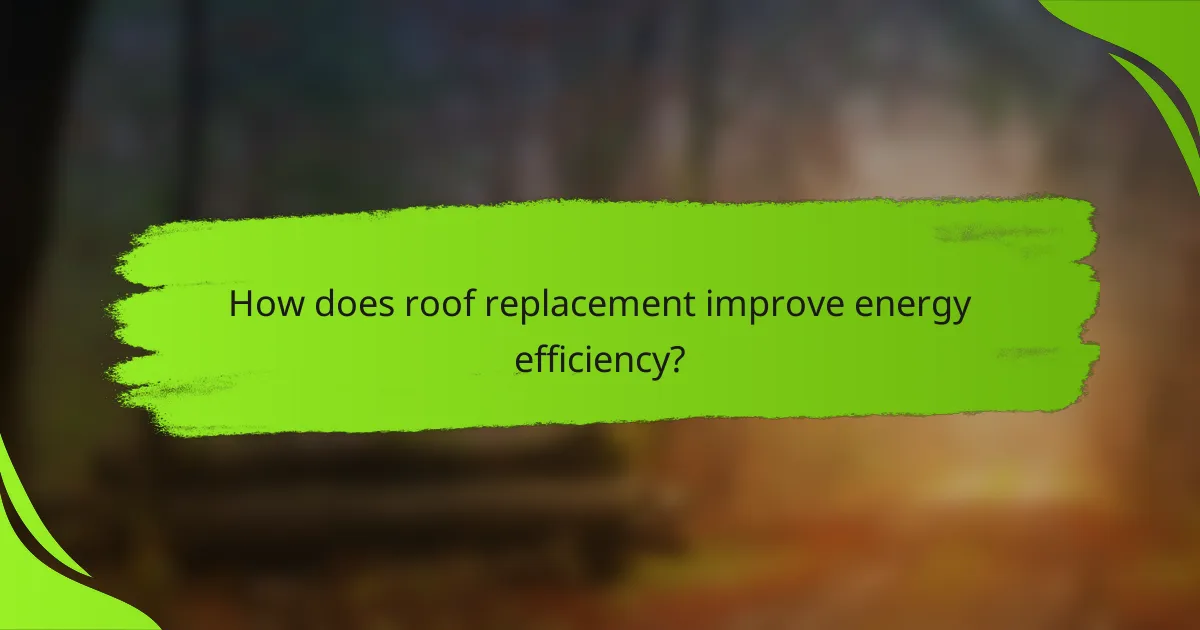
How does roof replacement improve energy efficiency?
Roof replacement enhances energy efficiency by using modern materials and techniques that reduce heat loss and improve insulation. This leads to lower energy bills and a more comfortable indoor environment throughout the year.
Energy-efficient materials
Choosing energy-efficient roofing materials is crucial for improving a home’s energy performance. Options such as metal, slate, and certain types of asphalt shingles are designed to reflect more sunlight and absorb less heat. This can significantly lower cooling costs during hot months.
When selecting materials, consider their thermal resistance, often indicated by an R-value. Higher R-values mean better insulation, which is essential for maintaining indoor temperatures efficiently.
Insulation upgrades
Upgrading insulation during a roof replacement can drastically improve energy efficiency. Proper insulation helps keep heat inside during winter and outside during summer, reducing the workload on heating and cooling systems. This can lead to energy savings of 10-50% depending on the existing insulation quality.
Common insulation materials include fiberglass, spray foam, and cellulose. Each has its own benefits and costs, so it’s important to evaluate which option best suits your needs and budget.
Reflective roofing options
Reflective roofing options, such as cool roofs, are designed to reflect more sunlight and absorb less heat than standard roofs. These materials can lower roof surface temperatures by up to 30% compared to traditional roofing, which translates to less heat entering the building.
When considering reflective roofing, look for products that meet ENERGY STAR standards. These roofs not only improve energy efficiency but can also extend the lifespan of your roof by reducing thermal stress.
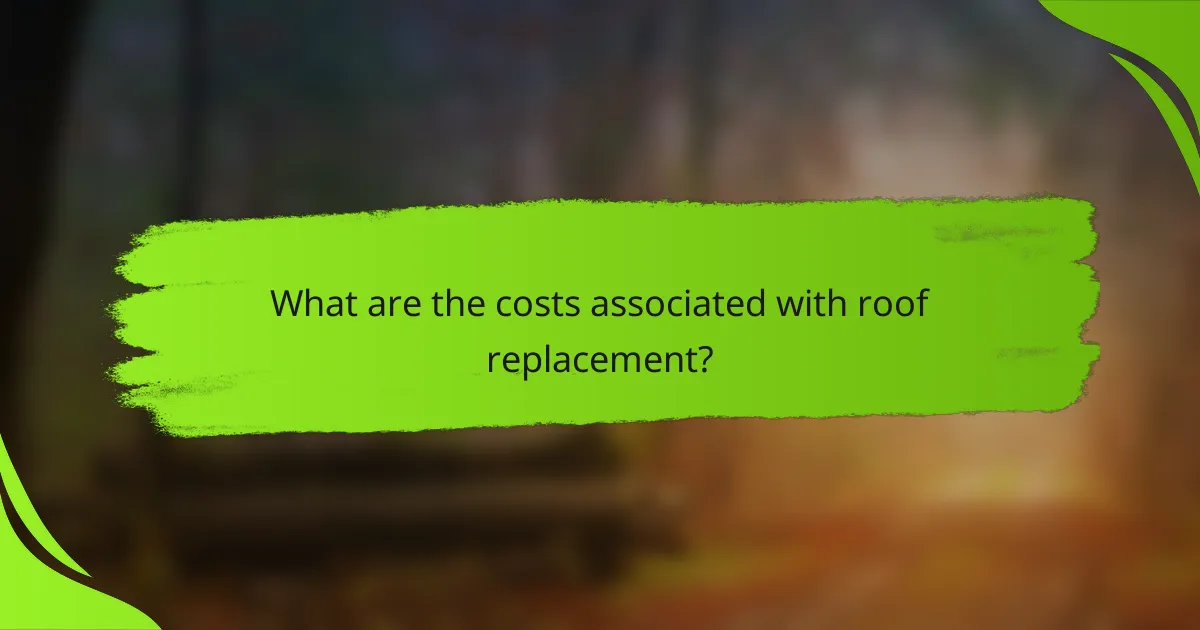
What are the costs associated with roof replacement?
The costs associated with roof replacement can vary significantly based on materials, labor, and the complexity of the project. Homeowners should expect to spend anywhere from several thousand to tens of thousands of dollars, depending on these factors.
Average cost per square foot
The average cost for roof replacement typically ranges from $3 to $10 per square foot. This price can fluctuate based on the type of roofing material chosen, with asphalt shingles being on the lower end and metal or slate options costing more.
For a standard 2,000 square foot home, total costs could fall between $6,000 and $20,000. It’s essential to get multiple quotes to ensure a competitive price.
Factors affecting pricing
Other factors include the roof’s pitch, accessibility, and any necessary structural repairs. Local labor rates and building codes may also impact the final price, so it’s wise to consult local contractors for accurate estimates.
Financing options available
Additionally, homeowners may consider home equity loans or lines of credit, which often provide lower interest rates. Government programs may also be available for energy-efficient upgrades, so researching local incentives can be beneficial.
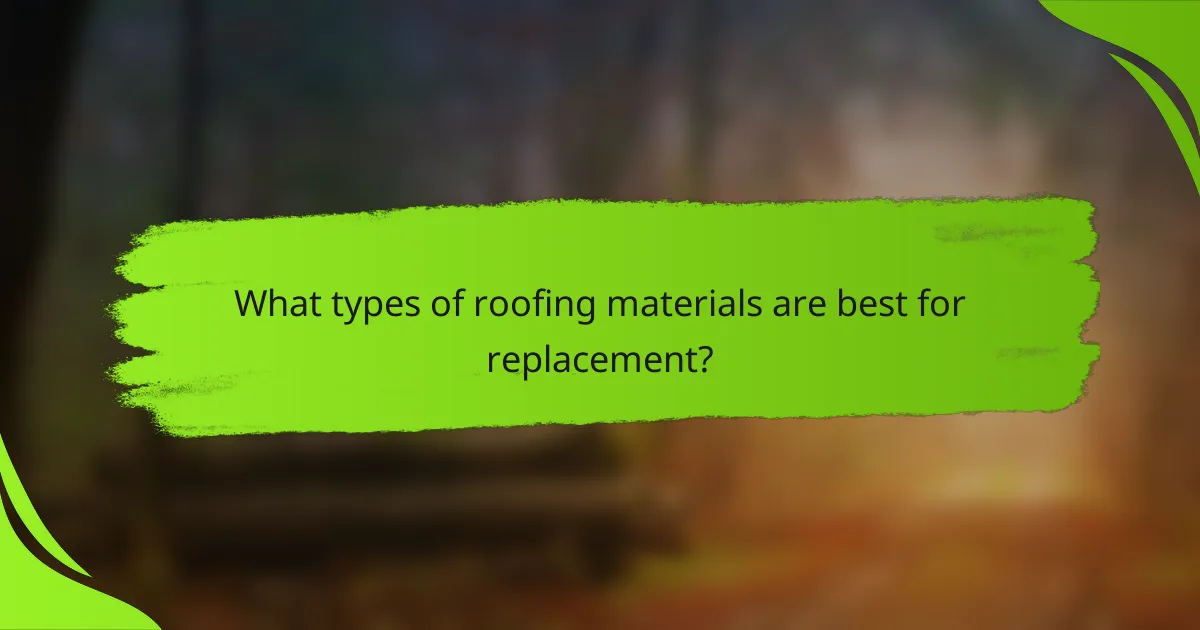
What types of roofing materials are best for replacement?
Choosing the right roofing materials for replacement is crucial for enhanced protection, energy efficiency, and aesthetic appeal. The best options typically include asphalt shingles, metal roofing, and tile roofing, each offering distinct advantages based on durability, cost, and style.
Asphalt shingles
Asphalt shingles are one of the most popular roofing materials due to their affordability and ease of installation. They generally last around 20 to 30 years and come in a variety of colors and styles, making them versatile for different home aesthetics.
When considering asphalt shingles, look for products with a high warranty period, which often indicates better quality. Be aware that they may not perform as well in extreme weather conditions compared to other materials.
Metal roofing
Metal roofing is known for its durability and longevity, often lasting 40 to 70 years. It provides excellent protection against severe weather and can significantly improve energy efficiency by reflecting solar heat.
While the initial cost of metal roofing can be higher than asphalt shingles, it can lead to savings in energy bills and maintenance over time. Ensure proper installation to prevent issues like rust or leaks, and consider local climate factors when selecting the type of metal.
Tile roofing
Tile roofing, made from materials like clay or concrete, offers a distinctive look and exceptional durability, often lasting over 50 years. It is highly resistant to fire and can withstand harsh weather conditions, making it a great choice for longevity.
However, tile roofing can be heavy and may require additional structural support, which can increase installation costs. Additionally, it is generally more expensive than both asphalt and metal options, so budget accordingly if you choose this route.

How to choose a roofing contractor?
Choosing a roofing contractor involves evaluating their qualifications, obtaining multiple estimates, and understanding warranty options. This ensures you select a reliable professional who meets your needs and budget.
Check credentials and reviews
Start by verifying the contractor’s credentials, including licenses, insurance, and certifications. Look for reviews on platforms like Google, Yelp, or local directories to gauge their reputation.
Pay attention to feedback regarding their workmanship, reliability, and customer service. A contractor with consistently positive reviews is more likely to deliver quality work.
Get multiple quotes
Obtaining multiple quotes helps you understand the market rate for your roofing project. Aim for at least three estimates to compare pricing, materials, and timelines.
When reviewing quotes, ensure they include similar specifications to make an accurate comparison. Be cautious of quotes that are significantly lower than others, as they may indicate subpar materials or workmanship.
Assess warranty options
Understanding warranty options is crucial when selecting a roofing contractor. Most contractors offer warranties on both materials and labor, which can vary in duration and coverage.
Inquire about the specifics of each warranty, including what is covered and the process for making a claim. A solid warranty can provide peace of mind and protect your investment in the long run.
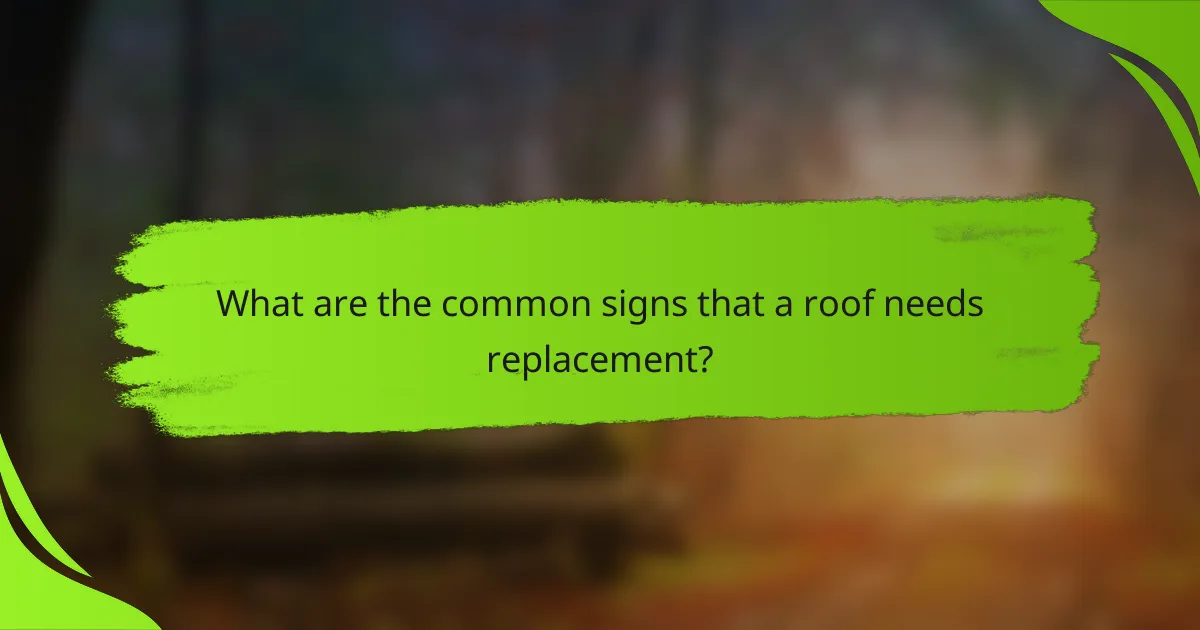
What are the common signs that a roof needs replacement?
Common signs that indicate a roof needs replacement include visible damage, leaks, and age-related wear. Homeowners should look for curling shingles, missing tiles, or water stains on ceilings as key indicators that a roof may no longer provide adequate protection.
Visible damage
Visible damage is one of the most straightforward signs that a roof needs replacement. Look for cracked, curled, or missing shingles, which can compromise the roof’s integrity. If you notice significant wear in multiple areas, it may be time to consider a full replacement.
Additionally, check for damage around chimneys, vents, and skylights, as these areas are often prone to leaks. If you see any gaps or deterioration, it could signal that the roof is no longer effectively protecting your home.
Leaks and water stains
Leaks and water stains inside your home are critical indicators that your roof may need replacement. If you notice water spots on ceilings or walls, it suggests that water is penetrating through the roof. This can lead to further damage, including mold growth and structural issues.
To assess for leaks, inspect your attic for damp spots or mold. If leaks are frequent or widespread, replacing the roof might be the most effective solution to prevent ongoing issues.
Age of the roof
The age of your roof is a significant factor in determining whether it needs replacement. Most roofs have a lifespan ranging from 20 to 30 years, depending on the materials used. If your roof is approaching or exceeding this age, it is advisable to have it evaluated for potential replacement.
Even if there are no visible signs of damage, older roofs may not provide the same level of energy efficiency or protection as newer models. Regular inspections can help you assess the condition of an aging roof and make informed decisions about replacement.
